The Creation of Regolith and Soils—Impact Cratering and Other Processes
Abstract
The regolith is the layer of rock fragments that is exposed to space on airless body surfaces. This layer is present on all airless bodies visited thus far, including small asteroids like Itokawa that were once expected to be bare monoliths. Regolith on the Moon, Mercury, and large asteroids like Vesta is created via impact, which serve to fracture and pulverize intact rock and also create impact craters, the most common landform seen on airless bodies. However, other processes, such as thermal fracturing, also play a role, and we are beginning to understand how each process affects the constantly evolving result.
Keywords
Airless bodies; Cratering; Regolith; Impact; Processes; Simple craters; Complex craters; Basins
More than any other process, impact events are responsible for the creation and subsequent evolution of regolith on airless bodies. However, other processes, such as thermal fracturing, also play a role, and we are beginning to understand how each process affects the constantly evolving result.
Definitions
Particle sizes in geology are often named following the Wentworth Scale, defined in 1922 by Chester K. Wentworth. The smallest size ranges in the Wentworth Scale, “silt” and “mud” or “clay,” have implications that would be confusing in an extraterrestrial setting. Table 7.1 shows an adaptation of the Wentworth Scale we use in this work, replacing these categories with “dust” as well as combining other categories. We note that this scale is not an official one, especially with the modification we make here. We also note that the term “block” has been adopted by some as a generic term for a particle regardless of size, for instance when describing the size-frequency distribution on a planetary surface that covers several of these categories.
Table 7.1
| Diameter | Name | |
|---|---|---|
| > 25 cm | Boulder | |
| 64 mm–25 cm | Cobble | |
| 2–64 mm | Gravel | |
| 1–2 mm | Very coarse sand | “Sand” covers whole range |
| 500 μm–1 mm | Coarse sand | |
| 250–500 μm | Medium sand | |
| 125–250 μm | Fine sand | |
| 63–125 μm | Very fine sand | |
| < 63 μm | Dust | |

As discussed in Chapter 4, the upper portions of the surfaces of airless bodies comprise a pulverized and mixed layer of material known as the regolith. The term “soil” on airless bodies usually refers to the smaller sized (finer-grained) fraction of the regolith. The terms regolith and soil can be found being used interchangeably when referring to airless bodies, although in this case the word soil carries none of the connotations it does in the terrestrial case. On the Earth, soil contains organic matter derived from living or once-living organisms.
Importance of Regolith
Regolith is an important feature of airless bodies for a host of reasons. One is due to simple geometric considerations alone: 6% of the volume of a 1-km sphere is within 10 m of its surface, for instance, and the overturn and exhumation processes in regolith increases the likelihood that a given mass has spent time at the surface of an airless body. Regolith is an excellent thermal insulator. It blankets underlying material and buffers temperature changes. It also protects the target bedrock from impacts of small-to-moderate size, redistributing energy. Variations in the regolith can create pockets that sequester volatiles (Chapters 8 and 10).
On small bodies, the regolith is where the material for new asteroids is generated. The members of collisional families are made from impact ejecta preferentially derived from near-surface regolith. Asteroidal satellites are thought to be generated from regolith lifted from surfaces by nongravitational forces, and those satellites can tidally evolve and escape. Because regolith is continuously generated, a surprisingly large fraction of the volumes of airless bodies has spent time as regolith, and thus was subjected to the processes found on planetary surfaces.
The regolith takes on additional importance because practically every measurement made on airless bodies (with the exception of gravitational or seismic measurements) involves only regolith: reflectance or emission spectroscopy, gamma-ray, X-ray, or neutron spectroscopy, even in situ measurements and sample returns are conducted with regolith (Chapter 4). These different techniques can probe different depths of the regolith, but true exposures of bedrock are rare or absent on the airless bodies. As a result, understanding the regolith, how it relates to the bulk object, how it alters with exposure to cosmic rays, UV light, etc. is of paramount importance for properly understanding solar system bodies and those meteorite samples that do originate in the deep subsurface of objects. When we study airless bodies, it is the regolith we truly study.
Impact Events and Crater Formation
Impact events are simple in concept—one object in space hits another object. The outcome of this impact depends largely on the energy, i.e., the size and relative velocity of the two objects involved in the collision. The larger object is often referred to as the “target” while the smaller object is the “impactor.” (Although these definitions are less meaningful when the objects are similar in size.) The highest energy collisions can vaporize and melt both the impactor and the target. Energies lower than that can destroy the impactor and leave visible scars called “impact craters” on the surface of the target. Impact events can occur with an impactor of almost any size, including down to the size of a particle of dust.
Large-scale impacts do more than create a large hole in the ground, they distribute ejecta, shatter and vaporize material, form melt, and cause both blanketing and mixing of target materials. Large-scale events also cause the degassing of target rocks as they are heated or melted, allowing for certain radiometric techniques to be conducted on the resulting cooled rocks (as previously discussed in Chapter 4). All of these processes affect how regolith is produced and how it changes with time.
Even if the impactor is relatively small, the energy of an impact event is invariably high. Bodies of all sizes are moving at high relative velocities, so even if the mass of one of the bodies involved in a collision is low, the velocity will still add a considerable fraction to the energy in the equation (E ∝ v2). Lunar impact speeds can be expected to be approximately 17 km/s or more (see Chapter 9).
Large-Scale Impacts
Excellent discussions of the specific details of the nature of impact cratering can be found in two specialized books by Melosh: Surface Processes, and Impact Cratering. We present here a basic look at the process and evolution of impact craters for context and completeness.
Crater formation can be described as occurring in stages, with different processes dominating at different times (Fig. 7.1). Impact craters are not “holes” dug out of the ground or circular dents similar to everyday experiences (a common misconception)—they are formed via such high energies that they are, effectively, explosions. The initial stage is that of the contact of the impactor with the target, and the beginning of compression of the target material. At this point, the energy of the impactor couples with the target and creates the shock that will eventually form the crater.
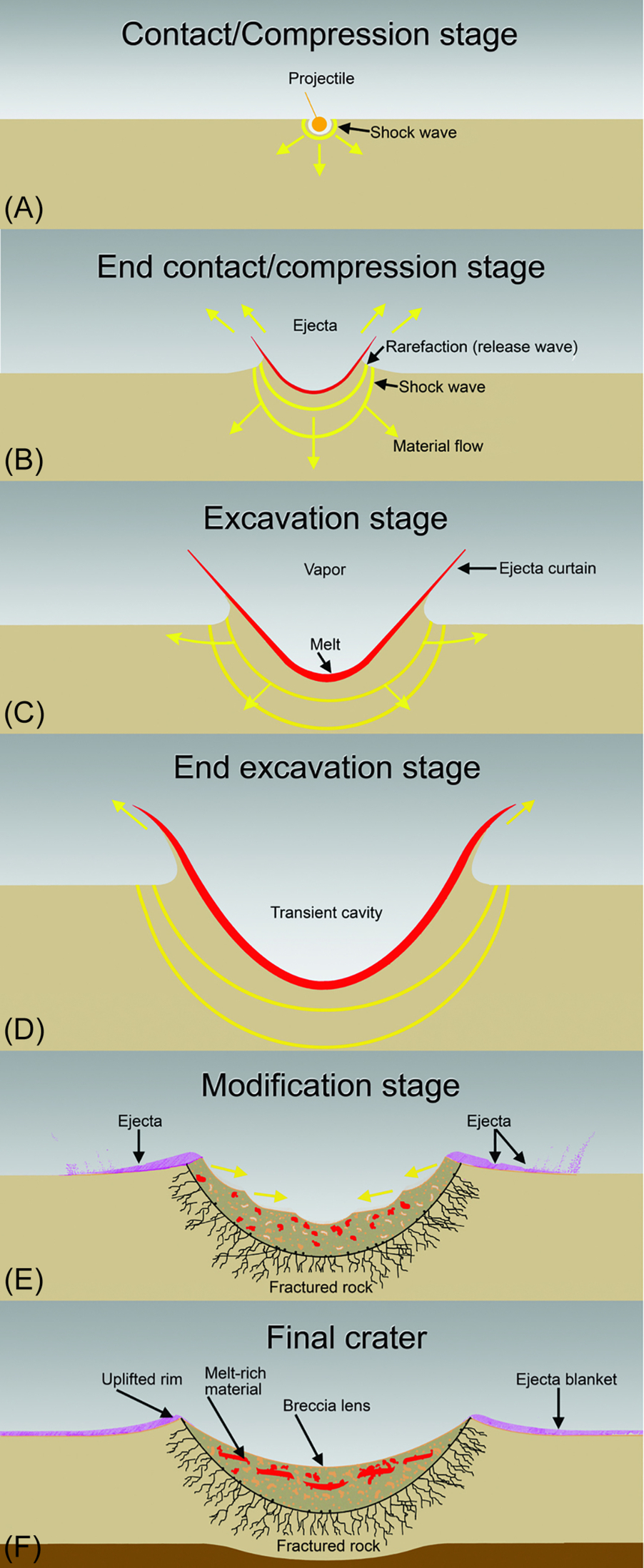
During contact and compression, a shock wave begins to propagate out from the crater, opening the cavity and compacting the rock underneath the target point in a hemispherical shape. The shock wave compresses the material it encounters under high pressure, but because the shock is of finite duration, the shocked material returns to its ambient pressure via passage of a rarefaction wave. As the process moves into the excavation stage, the cavity has opened, and material is flung outward in a cone-shaped ejecta wave due to the release of pressure from the passage of the rarefaction wave. The area under the target continues to compact and deform. At the end of the excavation stage, the crater has assumed its deepest form, called the transit cavity or transient crater. This form quickly collapses and fills during the modification stage.
Material forms a “blanket” of ejecta around the crater, and if rays are present, they may stretch many tens of crater diameters (or vastly more) away from the impact site. The target material is cracked, shattered, faulted, and mixed. Melt and other impact products may mix with this material or be found in coherent structures like melt lenses and pools within the rim of the crater. The final ejecta is “inverted” from the original target stratigraphy: it is from the deepest parts of the cratered material but is deposited last, and thus atop all of the other ejecta from shallower depths. Such inverted stratigraphy can be readily identified in terrestrial craters like that of Barringer (Meteor) Crater.
Impact ejecta blankets are thickest near the crater rim, and become thinner and more disconnected with increasing distance. Ejecta are distributed around the impact crater in two general emplacement zones. The first is the “continuous ejecta.” It is found closest to the crater, and effectively blankets the previous surface in a thick layer of hummocky material. The continuous ejecta blanket extends about one crater radius from the crater rim (Moore, et al., 1974). The second area is that of the “discontinuous ejecta.” In this area, the ejecta are intermittent, patchy, and possess many secondary craters.
Final craters form in three general types (Figs. 7.2 and 7.3). The most basic are “simple craters.” These are relatively small craters with a bowl or cone-like shape. Intermediate-sized craters will be more complex, and are accordingly named “complex.” These will show a central peak or peak-ring structure. The largest craters are “basins.” These are craters that are so large that the curvature and gravity of the target plays a major role in how they form. Basins often have a series of rims or rim arcs.
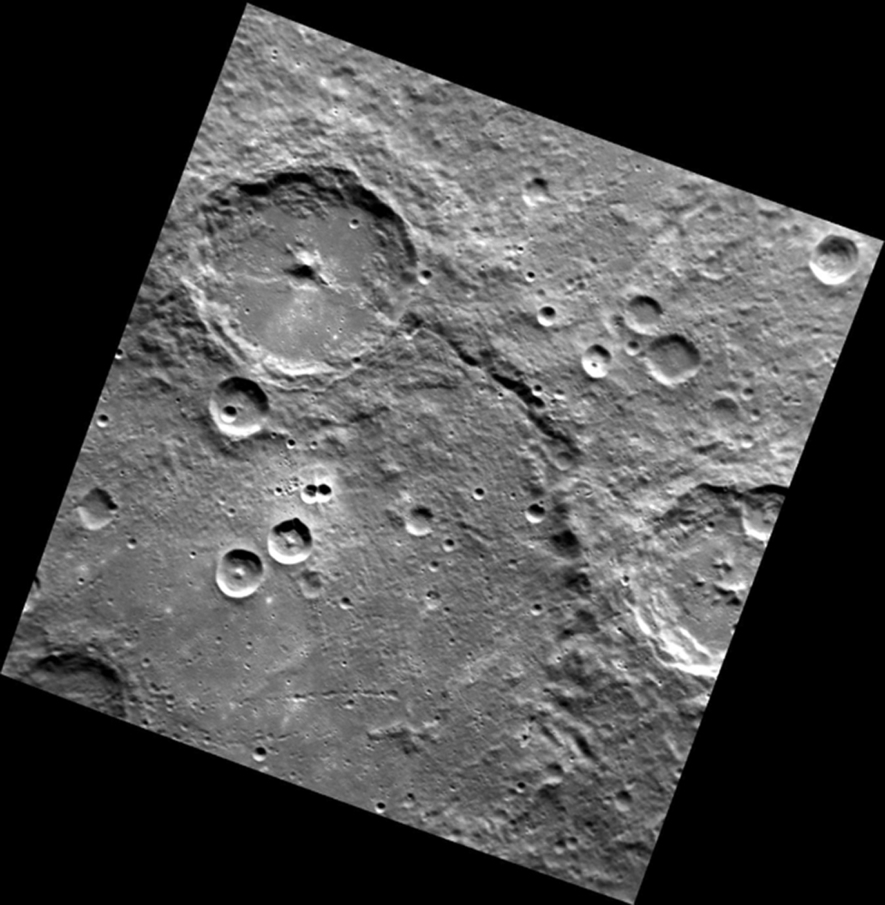
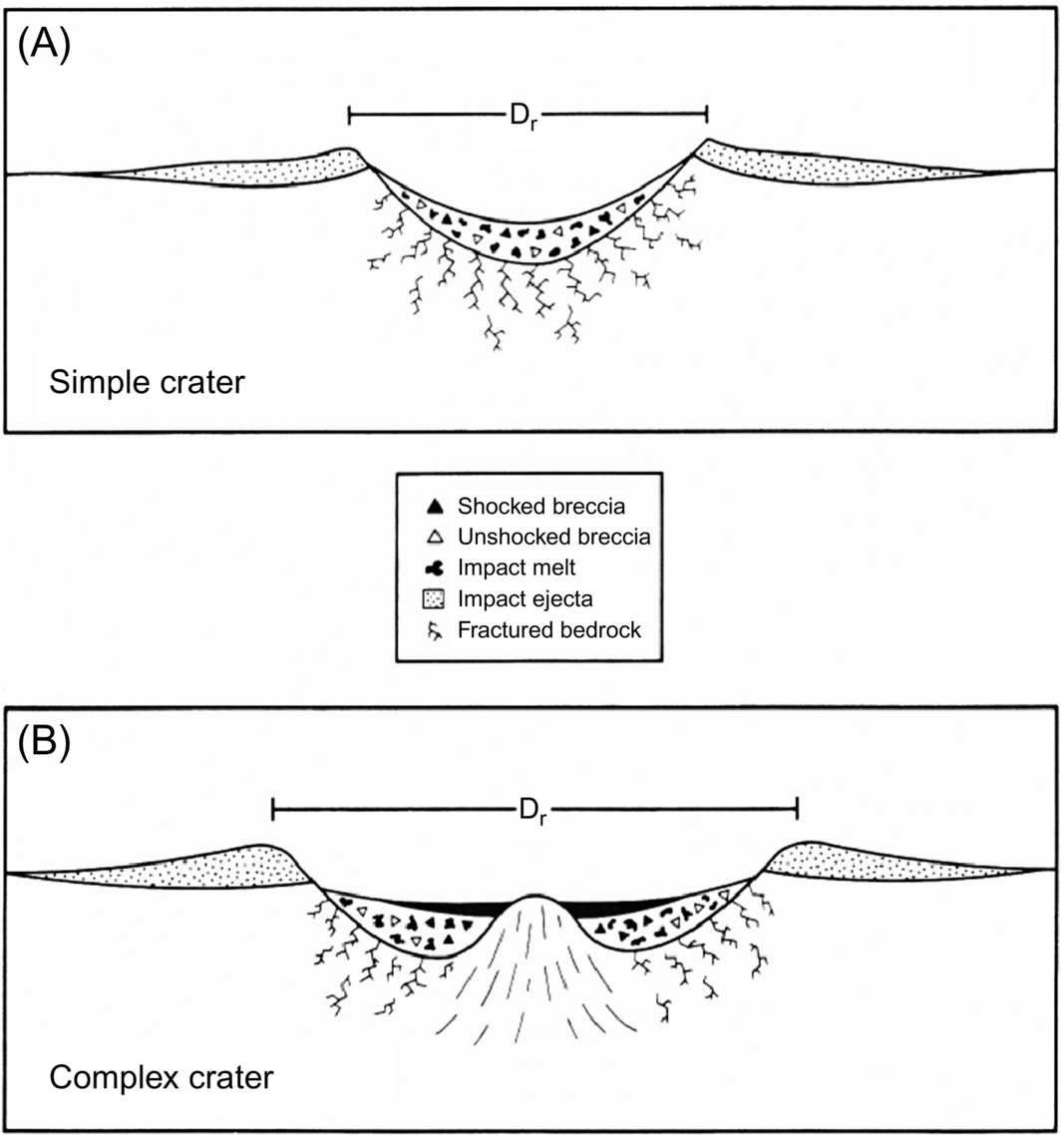
As noted, the form of a crater is a function of its size. However, the size at which craters transition from simple to complex is not the same on every planet. It is a function of the gravity of the target world. As the gravity of a planet increases, the size at which craters transition from simple to complex decreases. The result is that there are larger simple craters on the Moon than on planets such as Mercury and Mars. This trend continues for Vesta, although its relatively small surface area compared to the other objects reduces the number of each type of crater, which in turn makes it more difficult to define the transition diameter to the same precision as for larger airless bodies.
The reason for this dependence on gravity is related to the strength of the impacted material. The depth-to-diameter ratio for simple craters can vary, but typically is around 1:5. The heights of crater rims above the surrounding areas are another few percent of the crater diameter. As impact energies increase, crater sizes also increase, and thus so do the crater depths and rim heights. For sufficiently large impacts, the material strength of the target is unable to support the crater topography, especially given the additional fracturing and damage incurred as impact energy increases. This causes the simple-to-complex transition. The observed relation is because the burden of impact topography increases with an object's gravity while the internal strength of a material does not.
Interestingly, Ceres has a much smaller transition size than Vesta (~ 10 vs ~ 30 km) despite having a similar surface gravity. While Ceres doesn’t fit the trend including Vesta, Mars, the Moon et al., it does fit a trend similar to the rocky bodies but defined by the icy satellites of the giant planets and offset from the rocky body trend (Fig. 7.4). This is evidence that the cratered surface of Ceres has a different material strength than the rocky bodies. Indeed, we think it is much icier by nature than the other objects, and has affinities with both the rocky and icy airless bodies. The amount of ice necessary for craters on Ceres to have this icy satellite-like transition size but still meet other constraints is still uncertain, though it is thought to be roughly half ice and half rock. Studies of the simple-to-complex crater transition size on Trojan and outer-belt asteroids may be able to distinguish icier from ice-free objects. However, this could only be done with the largest Trojan asteroids, as can be deduced from Fig. 7.4.
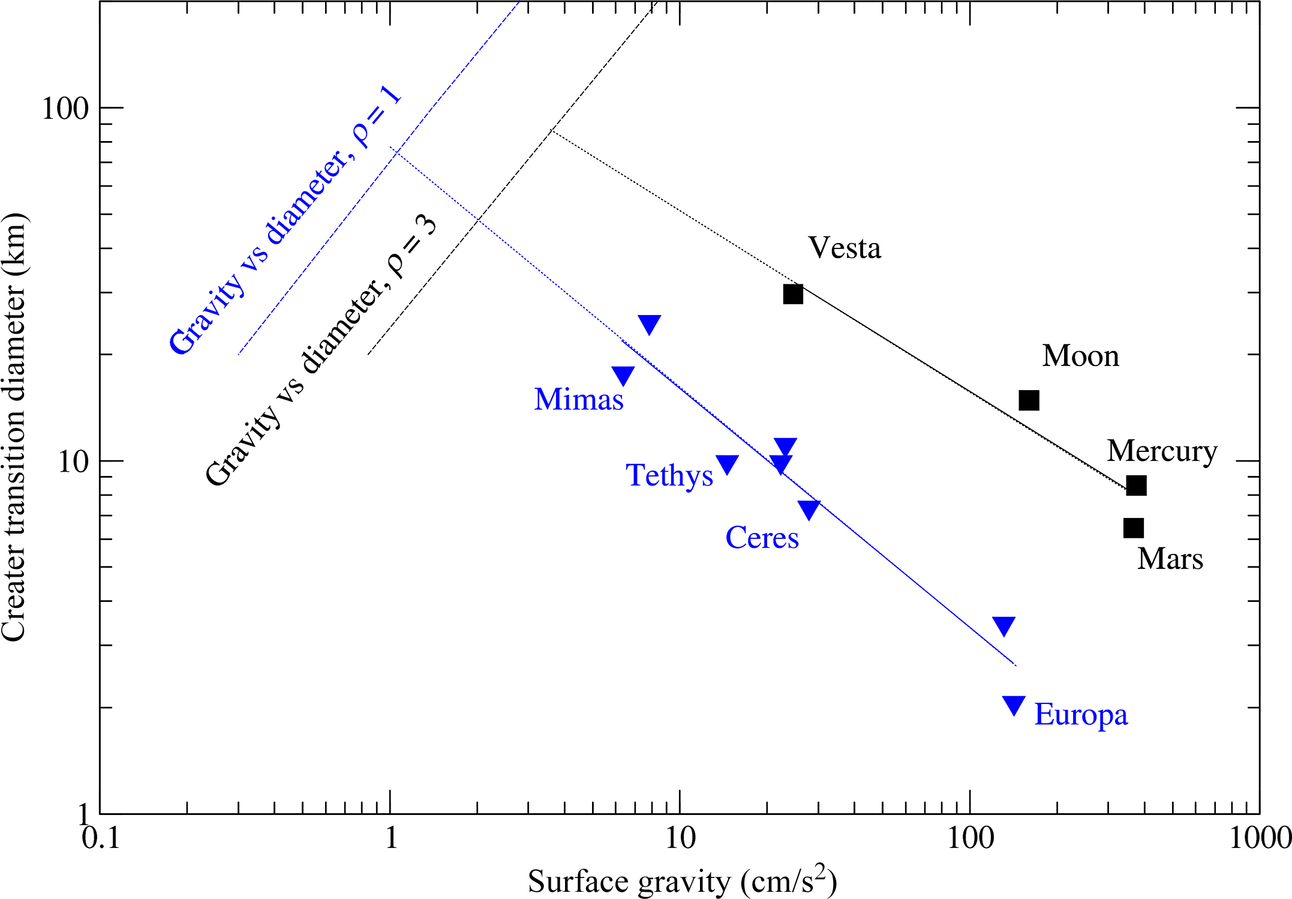
The largest impact craters in the solar system are the mighty impact basins. These are huge structures whose forms are dominated by the effects of gravity (Fig. 7.5). At this size, all the forces in the event, including gravity, generate a host of changes to the target rock. These include the formation of multiple rings, instead of one raised rim. Ring walls can show terraces or areas where they have failed, and “slumped.” This is distinctly different from smaller craters, where the forces involved produce less dynamic effects, like the relatively simple excavation and relocation of boulders inside and around a rim that retains a smooth profile.
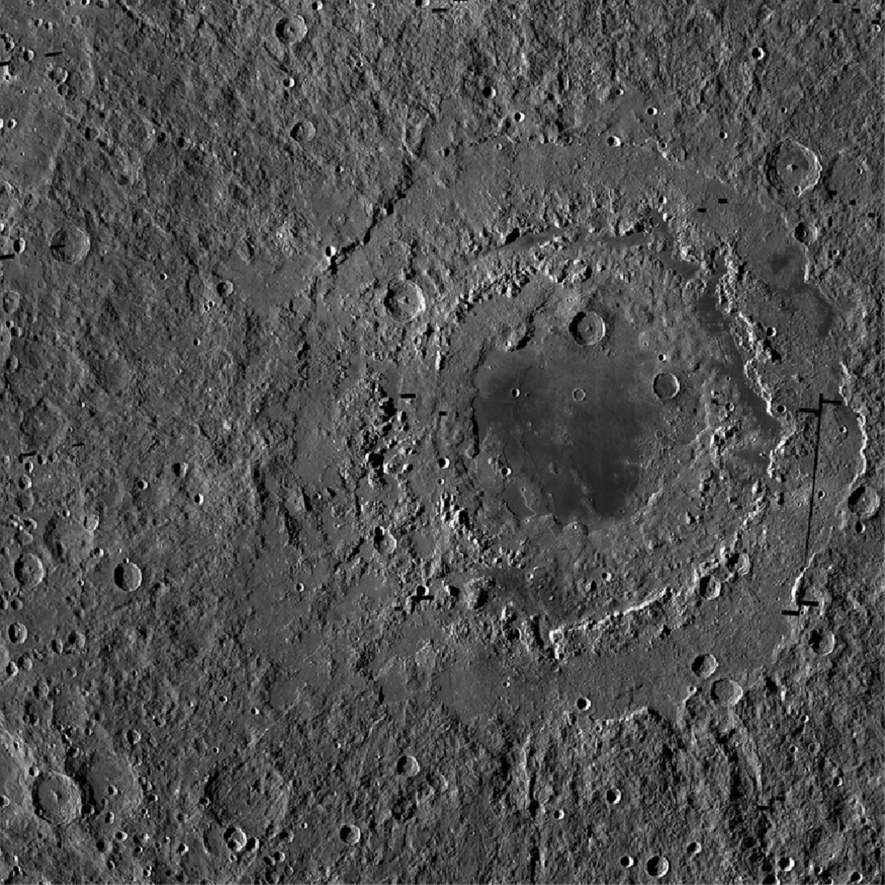
Fig. 7.6 shows an example of a lunar breccia returned by Apollo 14 astronauts. These rocks are composed of shattered pieces of preexisting rock that formed under different conditions, much like a conglomerate on Earth is composed of pebbles and fragments of earlier rocks. While conglomerates are cemented together via precipitation of minerals by groundwater here on Earth, regolith breccias are cemented together by impact melts or due to shock pressure, both of which are consequences of large impacts. Chapter 4 discusses the components of regolith that are found in breccias.

Small-Scale Impact Events
Small-scale (micrometeorite) impacts, which are much more frequent than larger ones, play an important role in the creation and evolution of regolith over time (Fig. 7.7). Small impacts not only distribute regolith through ejecta and gardening, but like larger impacts, they change the nature of the soil itself. As discussed in Chapter 4, soils mature with time as impacts and other processes alter the nature of the soils.
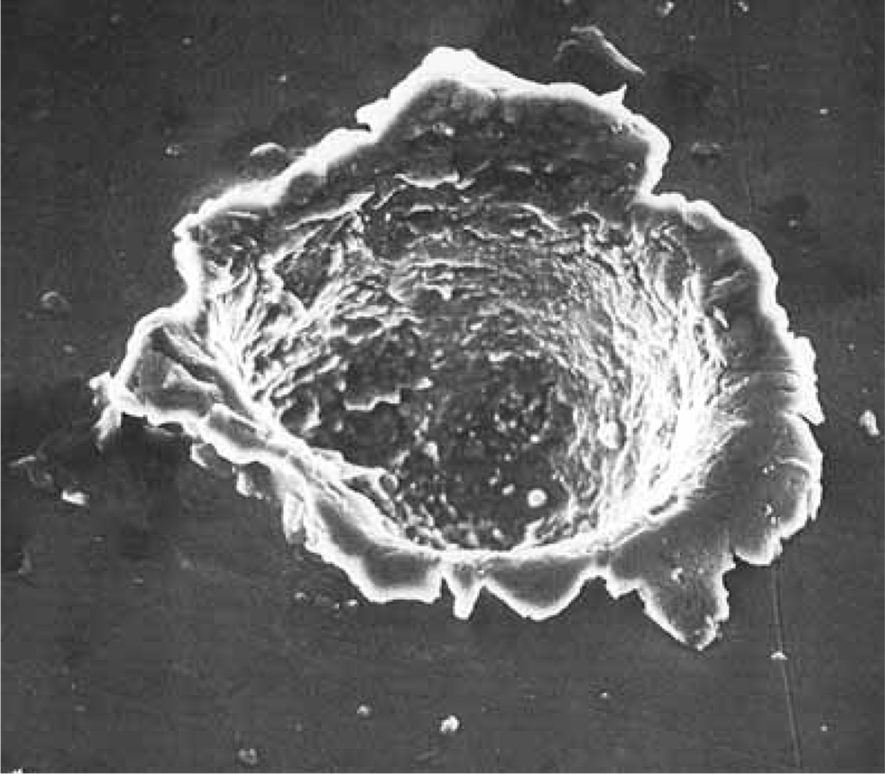
Micrometeorite impacts slowly but steadily abrade all exposed material on an airless surface. In a larger gravity well, such as on the Moon, small-scale impacts are energetic enough to form impact melt, which can cool to glass, just as can occur with larger impacts. Impacts therefore not only shatter tiny bits of rock, but also can “glue” these bits together with tiny splashes of melt (agglutinates).
Boulders
Once boulders are formed and emplaced by various processes, such as a large impact event or landslide, they become subject to the erosive effects that create soils (Fig. 7.8). The distribution of boulders on planetary surfaces is therefore time dependent. Micrometeorites bombard the surface, landslides and slumping take place, and ejecta from new craters is constantly being emplaced. However, the rate at which these processes occur, and their erosional effectiveness, is not fully understood. These effects vary from one object to the next depending upon their orbits, obliquities, and rotation periods. Thermal fracturing of boulders (discussed later in this chapter) may also be a key factor in the breakdown of boulders, and the subsequent contribution to the regolith.
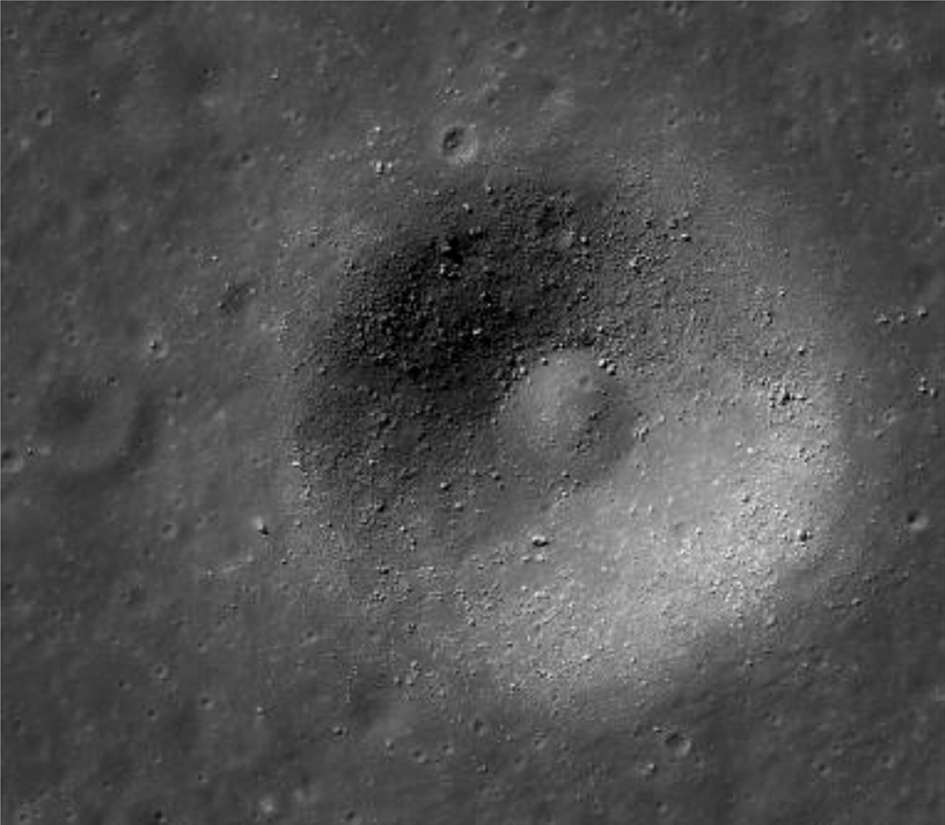
Laboratory experiments have shed light onto how long a boulder is expected to survive on the lunar surface before an impact would be expected to break it into smaller pieces (Horz et al., 1975). The estimates suggest a median survival time for a rock of about 10 cm in diameter to be 10 million years. About 35 Ma is necessary to destroy 99% of a boulder population. Subsequent remote-sensing work has supported these measurements: The boulder populations on small (105–950 m diameter) craters were compared with their estimated ages, and craters < 30 Ma still retained the bulk of their boulders, while craters older than 200 Ma retained only a few (Basilevsky et al., 2013, 2015). The work of Ghent et al. (2014) inferred similar boulder survival times. This general agreement is reassuring, particularly in light of the fact that the sizes of boulders as initially ejected by craters can vary widely (Bart and Melosh, 2007).
The boulder population on asteroids, especially smaller asteroids, may not be generated in quite the same way as on the Moon or Mercury. As has been mentioned in other chapters, it is thought that objects less than ~ 50 km in diameter were once part of larger objects, and there is evidence that sub-km objects like Itokawa are rubble piles held together only by gravity and some cohesive forces: effectively collections of impact ejecta that aggregated after escape from their parent object. The boulder size-frequency distribution on these rubble piles may be vastly different from what is seen on larger objects (Fig. 7.9).
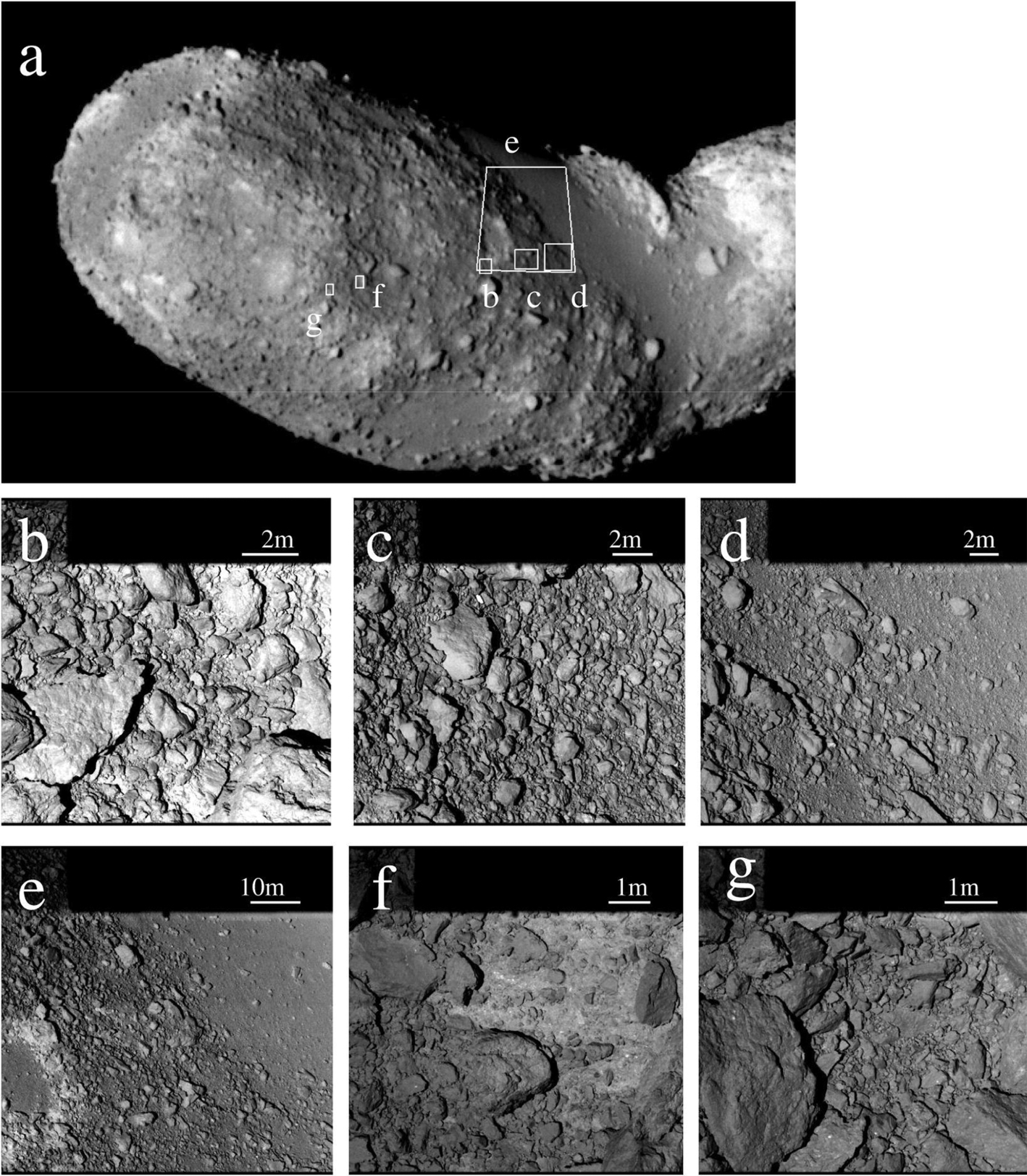
Gardening
As soon as fresh rocky material, such as an impact melt sheet or cooled flow of lava, is created on an airless surface, it is immediately subject to impact events and other processes that change its nature. One of the most obvious of these changes is that the rock is broken or shattered at all scales, creating smaller and smaller particles. The regolith of an airless body can have particles ranging in size from the very tiny, measured in micrometers, to the size of boulders measured in meters, depending on the nature of regolith retention on that body.
“Gardening” is the term for large- and small-scale mixing and overturn of regolith and soils. At small scales, impact gardening is very efficient at mixing, since smaller impacts happen more frequently. For the most part in the size-frequency distribution of NEOs, N ∝ D3, so for a given size, objects ten times larger impact a thousand times less frequently. With larger impacts being more rare, it is less common to stir the soil at depth, and therefore deeper regolith takes longer to mix. Lateral transport also occurs in larger impacts, as material from the target site can be flung tens of radii or more away from the resulting crater. This means that lunar samples may contain material that originated at a great distance from the location where it is collected or where it is examined by remote means (Fig. 7.10). On smaller objects with low gravity, even relatively minor impacts can transport material from any point on the surface to at any other point on the surface, sometimes after spending some time in a temporary orbit. As discussed later, it is thought that impacts into asteroids can completely disrupt them, with subsequent reaggregation and scrambling of their contents, with new material brought to the surface from the interior. Obviously, much material is also lost rather than merely “gardened”.
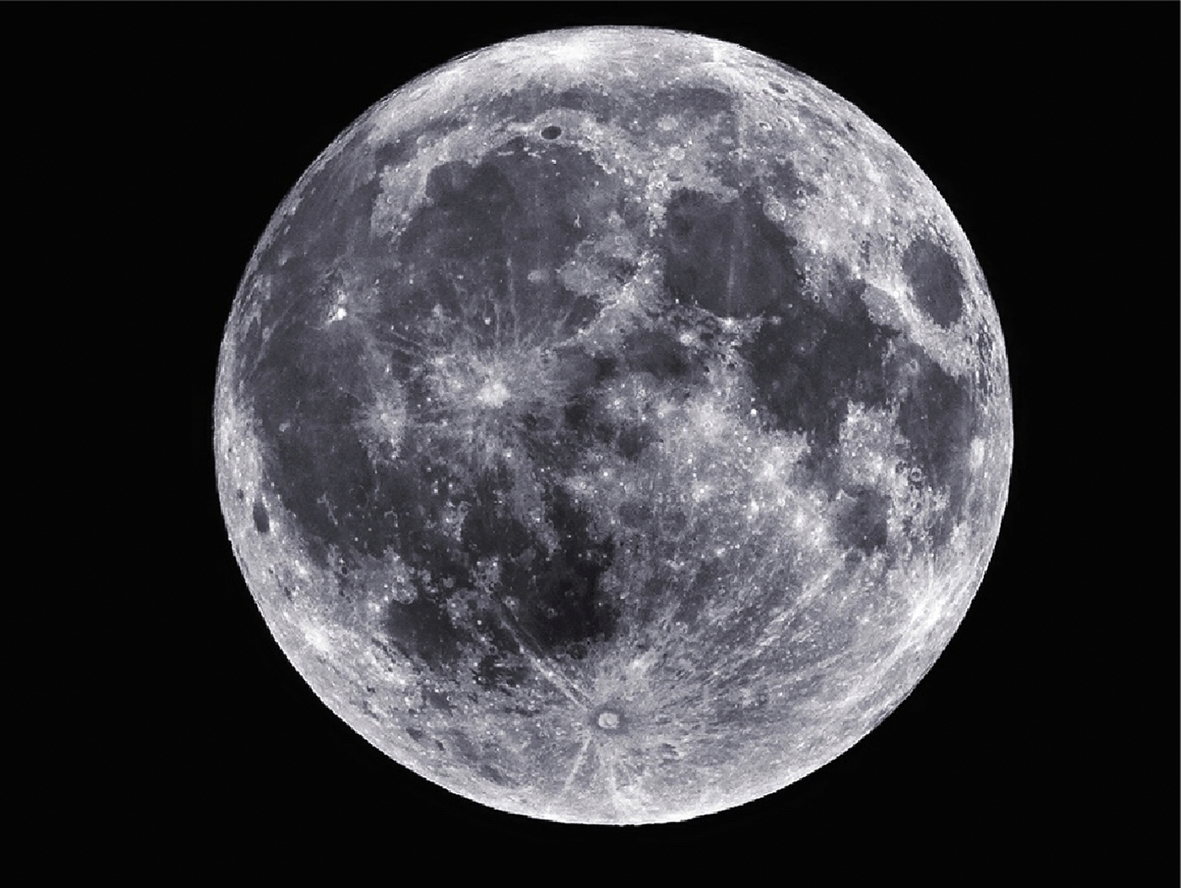
The Megaregolith
Mercury and the Moon, like Earth, have bedrock beneath their regolith. The process of creating regolith from a fresh, rocky surface is straightforward to describe, and we can imagine how a history of smaller and larger impacts could create a surface covered in fine particles of mixed local and distant origin, and that a sufficiently deep excavation should eventually reach heavily-impact-fractured material that is still in place from formation and, deeper still, reach intact rocky material. The term “megaregolith” is sometimes used to describe the layer of material that has been transported and disturbed, rather than simply fractured in place (Fig. 7.11). It can include large-scale ejecta, impact melt, and impact-fractured brecciated bedrock. The largest rocky asteroids like Vesta are thought to have a similar structure. The smaller gravity on these objects allows a larger fraction of ejecta to escape than would be the case for Mercury or the Moon, but the overall description still holds.
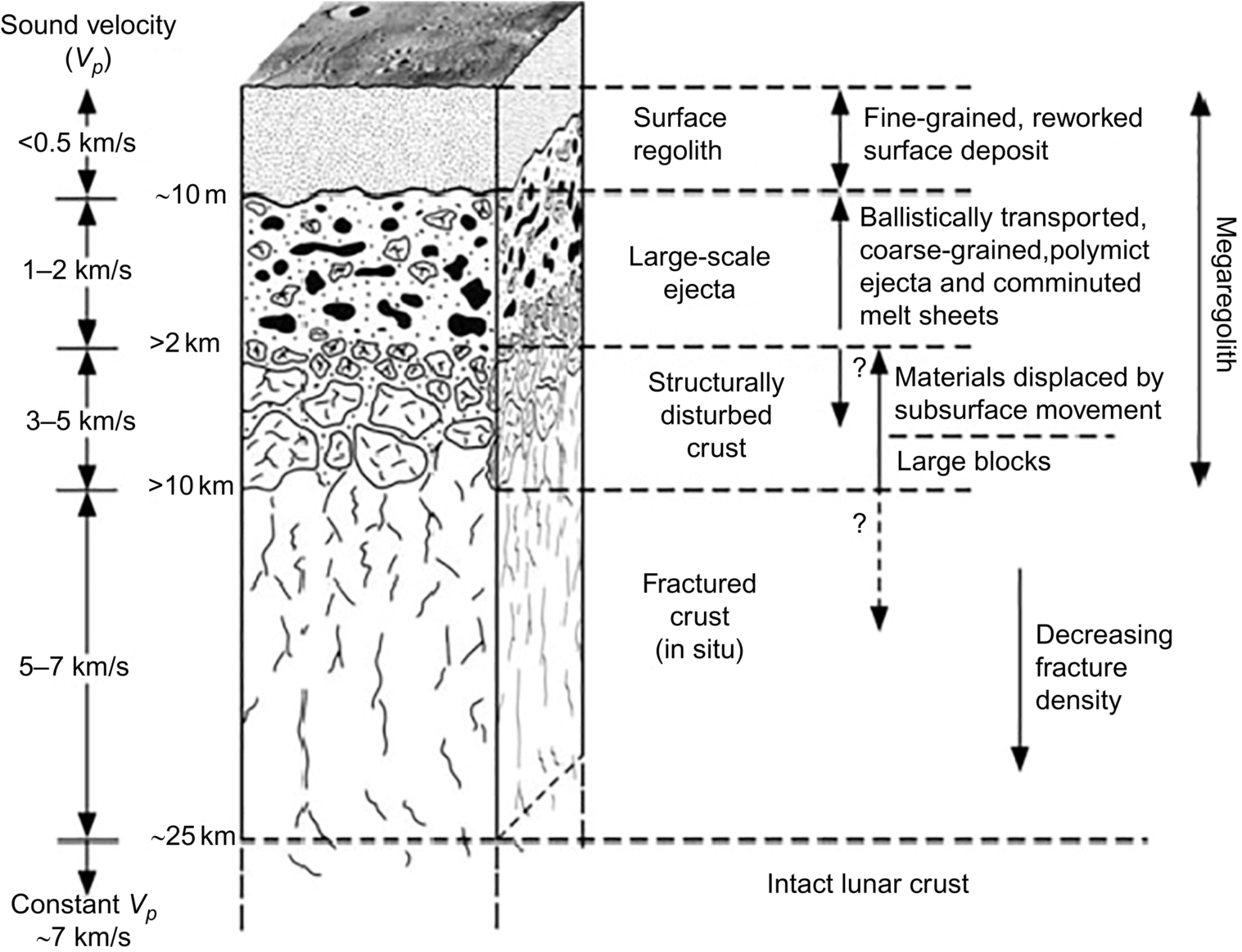
However, Vesta and its large cousins are the exception in the asteroid belt rather than the rule. There is evidence from density measurements that most asteroids have significant amounts of macroporosity, and it is not clear if “intact rocky material” exists in their interiors at all. Models of collisional evolution of asteroids also point in the same direction—many of the smaller asteroids are thought to be aggregates of impact ejecta that moved too slowly to escape their mutual gravitational attraction and instead reaccumulated into single objects. Such bodies, with so-called rubble pile internal structures, are effectively made entirely of megaregolith. Even those that are not reaccumulations are expected to be heavily fractured throughout their entire volumes.
Thermal Fracturing
Rocks are broken up by more than impacts. Fatigue is the term for the failure of material caused by small but repetitive forces rather than a single event with a force exceeding some threshold (like an impact or an earthquake). Fatigue can be activated by mechanical, thermal, or chemical effects, and contributes to the weakening and/or breakup of an object. On airless bodies, thermal fatigue in exposed rocks and landforms is driven by diurnal and seasonal thermal cycles, and is a long-term process that acts over their lifetimes. Thermal cycling induces mechanical stresses in these objects that drive the formation and propagation of cracks at different scales, weakening them and causing them to break apart over time. Airless bodies are thought to be uniquely susceptible to this process, though it is also relevant in fields as diverse as civil engineering, biomedicine, and art restoration.
Thermal fracturing processes are important anywhere there is a large, periodic change in temperature. On airless bodies, there is no atmosphere to buffer changes in temperature, say, from diurnal cycles. Many airless bodies also have orbits with high eccentricities, which can mean both a large change in temperature and a relatively close approach to the sun. Objects that are slowly rotating have more time to collect solar energy as well as to cool, and so can develop large temperature gradients. Fast rotators will not develop as high a temperature gradient, but the heating and cooling cycle will be operating more often. Each case has a unique effect on the development of damage.
Thermal fatigue operates simultaneously at multiple scales, but it is fundamentally driven by the propagation of cracks at a “micro” scale (Figs. 7.12 and 7.13). Composition plays a key role, as mineral grains with different properties may respond differently to changes in temperature, concentrating stresses along their boundaries. Microcracks will propagate in the direction that relieves the most amount of stress. In many materials, this is primarily along grain boundaries, but cracks may also propagate through an individual grain or through matrix material. Large grained materials are disaggregated more easily by these microscale cracks. Stresses also become concentrated at crack tips. Thus, thermal fatigue will exploit pre-existing fractures (or pore spaces) from impacts and other processes, as well as structural or compositional weaknesses, though it may also create new cracks at the same time. Individual microcracks will lengthen over time, and may coalesce with each other to form larger-scale features.
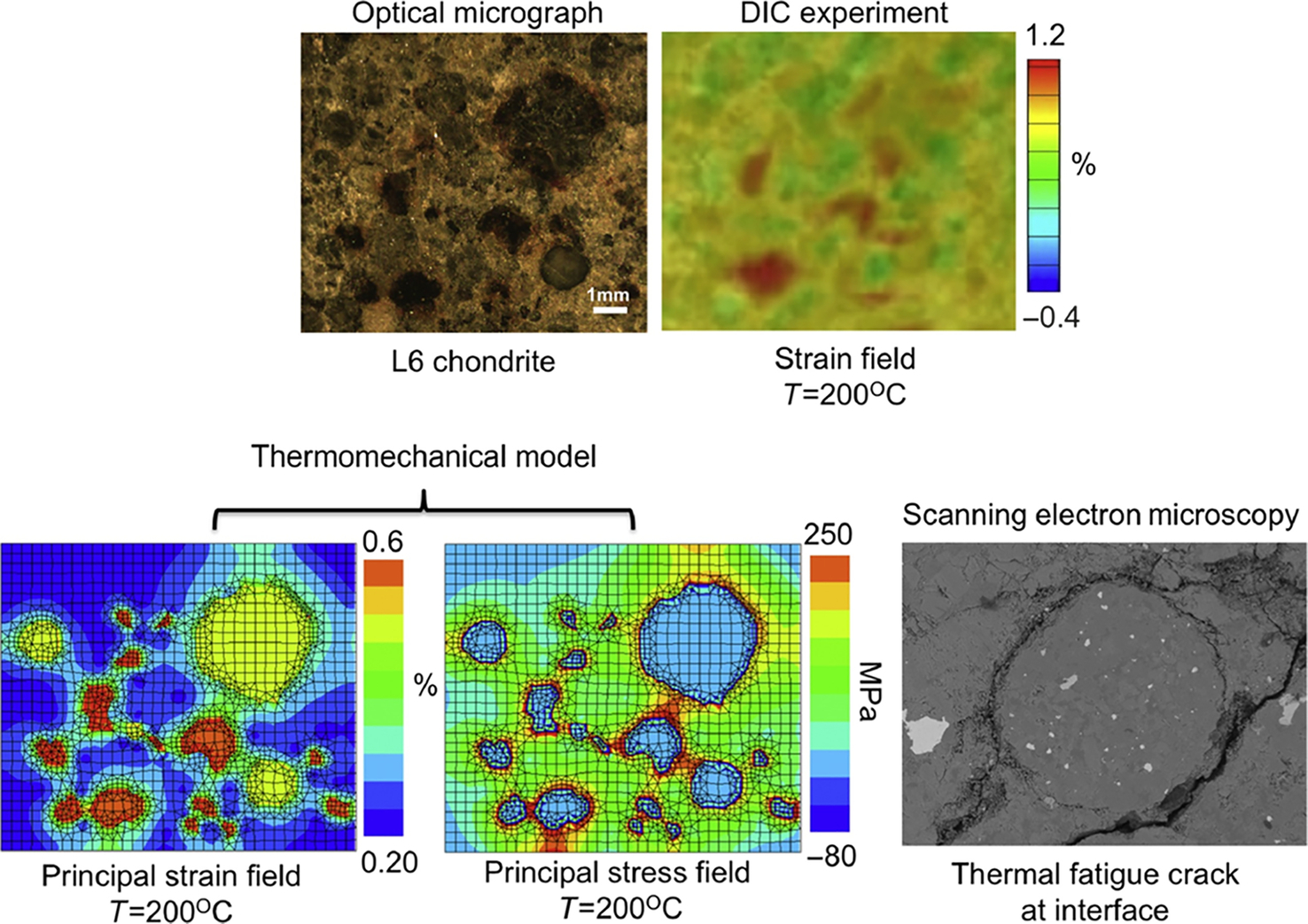
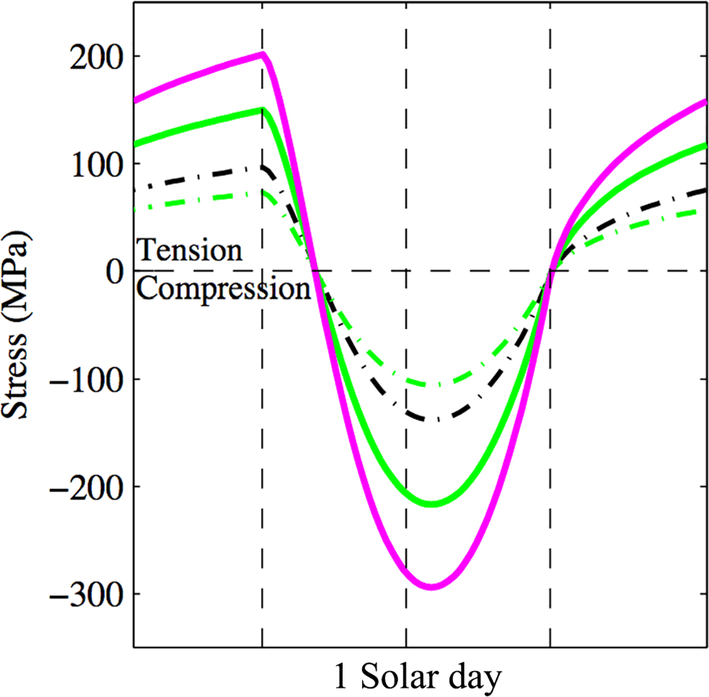
While small cracks are being developed and propagated at the “micro” scale, there are also effects at the “macro” scale (i.e., boulders in the 1–10 m range) that influence thermal fatigue. At the macroscale, the size and shape of a coherent block affects its response to the sun passing overhead. Stresses may develop in different parts of these objects at different times due to the temperature gradients that form throughout the thermal cycle. These effects will interact with what is occurring at microscopic scales, making thermal fatigue a highly complex process that develops and connects features across scales. Eventually, cracks that begin at the microscale can grow into macroscopic features, disaggregating material from block surfaces. Stresses are proportional to the change in temperature the rock experiences, and so how rocks break down will be unique in each thermal environment.
Fracturing of rocks on airless body surfaces via thermal fatigue is the subject of several recent experimental and theoretical studies (Molaro et al., 2015, 2017; Delbo et al., 2014; Hazeli et al., 2018; Viles et al., 2010). As the rocks heat and cool, they expand and contract. If a rock is made of different components, such as the chondrules, matrix, and metal seen in ordinary chondrites, those components may have different coefficients of thermal expansion, leading to stresses within the rock. As described earlier, this process widens and elongates existing cracks in rocks as well as creating new ones. Eventually, as a crack gets sufficiently long relative to the size of a block, a small piece may spall off. Once that happens, both the new, smaller object and the fresh surface of the larger object are now subject to changes in how processes affect them. It is thought that this process might contribute to regolith formation or even be a driver of activity in some low-perihelion asteroids (see Chapter 11). Dombard et al. (2010) proposed that pond formation on Eros is driven by thermal fracturing and erosion, as material sloughs off of blocks to form new regolith and is spread by impact-induced seismic shaking until the surface of the still-intact block remnant retreats below the new regolith covering it.
Cracks will develop on the interior and exterior of boulders at the same time, but not at the same rate. As a rock accumulates damage, it experiences a reduction in its bulk strength and elastic properties. The more damaged it is, the more difficult it becomes to continue propagating cracks, and thus large, fresh boulders break down the most quickly. Fresh rocks have also sharp angles that are vulnerable to more rapid erosion. As processes such as thermal fracturing and microimpacts work together to break down rocks, regolith can develop on top of boulders. Boulders and smaller rocks may also become buried by regolith due to seismic shaking and other processes. Regolith can help thermally insulate rocks, lowering the temperature extremes they experience and reducing the damage caused by thermal fracturing. The insulating depth is dependent on the thermal skin depth.
Work has already shown there is an optimum size block on a given object at which thermal fracturing is most efficient. This size is related to the distance heat can penetrate over a diurnal or seasonal cycle, which is equal to ~ 5 × the “thermal skin depth” Lt, the depth at which the range of temperature variation falls by a factor of e:
where k is the thermal conductivity, P is rotation or annual period, ρ is density, and C is heat capacity. For asteroids, the thermal skin depth is roughly a few centimeters for low-obliquity objects, and so blocks smaller than that size are less likely to suffer thermal fracture. For the Moon, the thermal skin depth is perhaps 10 times deeper, and as a result we may expect large blocks to fracture, but for cm-sized blocks to suffer little thermal stress.
Impact processes are occurring concurrently with the thermal cycles. While the specifics differ with different orbits and compositions, the simulations point to thermal fatigue dominating among rock destruction processes in certain size ranges. The estimates of boulder ages as previously noted are for all active processes, and overall the relative efficacy of thermal fatigue versus impacts is not well constrained.
Lag Deposits
There is one additional way that regolith can form: as a lag deposit. This may happen if an important component of bedrock is thermodynamically unstable at the conditions found at the surface, leading to sublimation and eventually leaving a soil of stable components behind. This is thought to be an important process in cometary evolution. For the objects discussed in this book, this process is most relevant for objects like Ceres and other outer-belt asteroids with a lot of near-surface ice. A more detailed look at ice retreat will be found in Chapter 10, but we note here that on at least some objects regolith can be generated through neither impact nor thermal stresses.
Depth and Retention of Regolith
The processes that create regolith are discussed earlier. There are also processes that remove regolith from airless bodies: very large impacts can potentially throw ejecta off of an object altogether (though the impact itself will potentially create more regolith), and the YORP Torque (see Chapter 9) can increase the spin of small bodies to the point that they shed material.
The varying gravities of the Moon, Mercury, and asteroids lead to differences in ejecta escape after an impact, and thus to differences in ejecta retention and regolith retention. The escape speeds of Mercury (4.3 km/s) and the Moon (2.4 km/s) are much higher than those of Ceres (0.5 km/s) and Vesta (0.4 km/s). The vast majority of asteroids are much smaller than Ceres or Vesta and correspondingly have much smaller escape speeds. Eros, for example, has an escape speed of roughly 10 m/s. Phobos has a similar escape speed, while that of Deimos is smaller still at 5.6 m/s. On balance, it is thought that regolith accumulates with time on the Moon and Mercury. For asteroids, the question is a much more difficult one to answer.
The low escape speeds for the small bodies mean that relatively little material is retained after impacts. However, the fate of ejecta differs between the martian moons and asteroids. While it is relatively easy for material to escape Phobos and Deimos after an impact, slow ejecta will remain in orbit around Mars and may be reaccreted. Recent work shows that ~ 10%–20% of Deimos ejecta that crosses Phobos’ orbit hits Phobos, with ~ 25%–40% reaccreting to Deimos itself, 5%–10% hitting Mars, and the rest escaping the Mars system entirely. An even larger fraction of material that does not cross Phobos’ orbit will reimpact Deimos. In contrast, asteroids lose ejecta into heliocentric orbits. However, because the ejecta speed can be quite slow relative to the orbit speed, the ejecta remains in very similar orbits around the Sun to the object that generated the ejecta. Dozens of “collisional families” or “dynamical families” have been identified in the main asteroid belt, discussed further in Chapter 9.
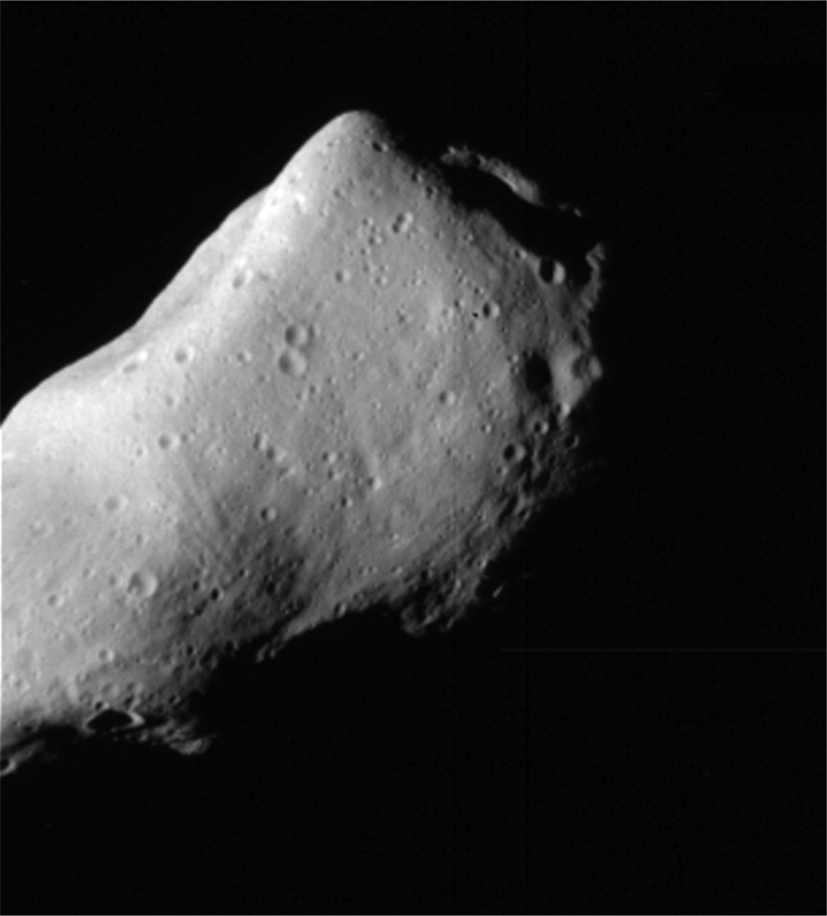
It was long thought that objects as small as asteroids did not have sufficient gravity to retain any regolith, until the Galileo flybys of Gaspra and Ida proved otherwise in the early 1990s (Fig. 7.14). Indeed, until those flybys, it was not recognized that asteroids could (or would) have rubble pile structures. Our changing understanding of the nature of asteroids makes the question of regolith depth a difficult one to answer for some of these bodies since they can be entirely made of regolith, as mentioned earlier.
Regardless, work to study the depth of the topmost regolith layer can be undertaken. These studies involve evaluating the morphology of craters, with crater interiors used for lunar modeling and a variety of other methods including the study of smaller craters preferred for asteroidal data, which tend to be of lower spatial resolution. Studies of regolith depth on Eros, Ida, and Gaspra suggest that it is tens of meters deep, while similar measurements on Phobos point to depths up to 100 m or more in places. Dawn images of Vesta indicate that the regolith on that body is over 1 km thick in some locations.
The Moon has much thinner regolith by comparison, especially when compared to overall body size. The lunar mare appears to have regolith depths of only ~ 5 m, while highland regolith is ~ 10 m deep. The MESSENGER mission is sufficiently recent that relatively little work has been done on the thickness of the mercurian regolith, but Kreslavsky and Head (2015) estimated a thickness of 25–40 m based on crater morphology and the scale dependence of roughness contrasts.
Summary
The regolith is the layer of rock fragments that is exposed to space on airless body surfaces. This layer is present on all airless bodies visited thus far, including small asteroids like Itokawa that were once expected to be bare monoliths. Regolith on the Moon, Mercury, and large asteroids like Vesta is created via impact, which serve to fracture and pulverize intact rock and also create impact craters, the most common landform seen on airless bodies. As impacts become more powerful, “simple” craters grow in size until they reach a “transition diameter” at which point larger, “complex” craters with additional interior features are created. The transition diameter is a function of a body's size and composition. Basins are the largest impact structures, and typically have object-wide effects when forming.
On large objects, the regolith (with particle sizes on order μm-cm) gives way at depth to “megaregolith,” a region of fractured and disturbed material. The megaregolith can be kilometers thick on the Moon. Asteroids like Eros, with diameters of order 10 km, may be thought of as megaregolith through their entire volume, with no intact bedrock in their interiors. Asteroids like Itokawa, with diameters of a few hundred meters, appear to be reaccumulated ejecta from impacts into much larger parents, and effectively are regolith through their entire volumes. The transition size from objects like Eros to objects like Itokawa is not yet known, given the few asteroid encounters that have taken place.
In addition to creation via impact, regolith can form via thermal fatigue. While we are still in the initial stages of understanding this process, there is evidence it can be the dominant process in rock destruction for some sizes of blocks.
